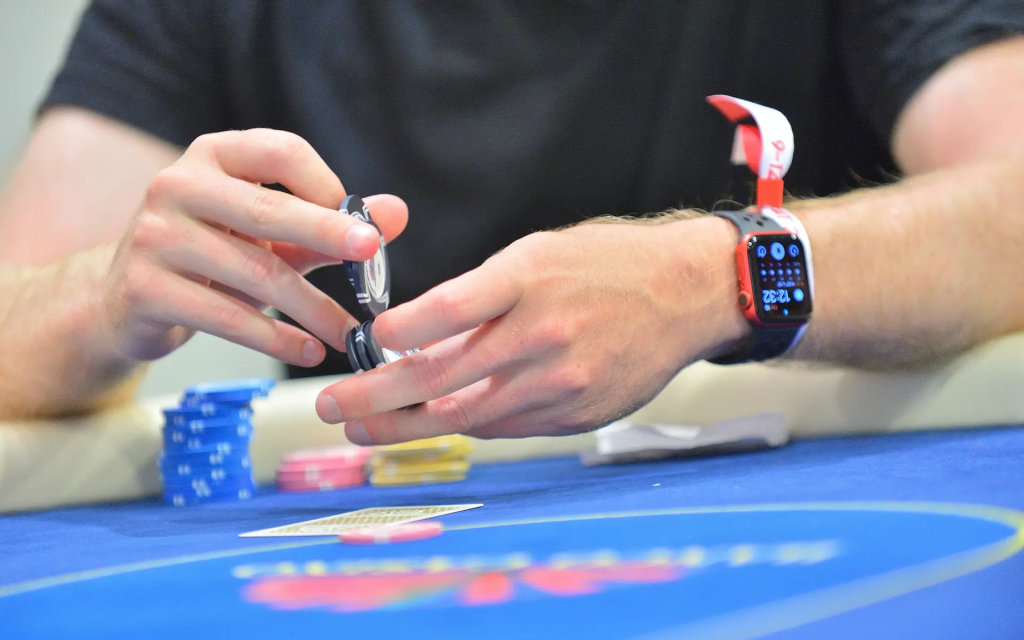What is a 3 bet in poker? In the world of poker, three betting has become an essential strategy that separates casual players from seasoned pros. But what is three betting in poker, and why has it gained such prominence? Simply put, a 3 bet occurs when a player re-raises after an initial raise and a subsequent re-raise. This move not only increases the stakes but also adds a layer of psychological warfare to the game, forcing opponents to make tough decisions early on. As the game has evolved, understanding 3 bet poker has become crucial for anyone looking to gain an edge at the table.
What is a 3bet in poker? The rise of aggressive playstyles in modern poker has made three betting more than just a tool for maximizing value with strong hands; it’s now a method for bluffing, controlling the pot, and exploiting the tendencies of opponents. Whether you’re playing in a high-stakes tournament or a casual cash game, mastering the art of three betting can dramatically enhance your gameplay.
What is a 3 Bet in poker?
In poker, understanding what is a 3 bet in poker is fundamental to mastering the game. A 3 bet refers to the third bet in a sequence, which occurs after an initial bet (the opening bet or raise) and a subsequent re-raise. Specifically, the blinds in a game like Texas Hold’em are considered the first bet, the opening raise is the second, and the re-raise is the 3 bet. This move is a powerful tool that can drastically alter the dynamics of a hand.
So, what does 3 bet mean in poker beyond just being the third bet? The significance of a 3 bet lies in its ability to shift the momentum of the game. When a player three bets, they are signaling strength, indicating that they either have a strong hand or are attempting to represent one. This can force opponents into difficult decisions—whether to call the larger bet, fold and concede the pot, or escalate with a 4 bet.
What is a 3 bet in poker? The mechanics of a 3 bet are straightforward. Suppose you’re playing a $1/$2 No-Limit Texas Hold’em game. The big blind posts $2, which is the first bet. A player in middle position raises to $6, making it the second bet. If you then re-raise to $18, you are making a 3 bet. This action not only increases the pot size but also pressures the original raiser to respond, either by calling, folding, or further escalating with another re-raise.
Players typically choose to three bet for several reasons. One common scenario is when a player has a premium hand, like pocket aces or kings, and wants to extract more value from their strong holding. Another reason might be to bluff or semi-bluff, where the player does not have the best hand but believes they can force their opponent to fold better hands. Additionally, a 3 bet can be used to gain control of the pot and dictate the pace of the hand, especially when in position against an opponent.
For example, imagine you’re on the button with Ace-King offsuit. The player in the cutoff raises, and you decide to three bet. By doing so, you’re applying pressure, trying to isolate the initial raiser, and hoping to either win the pot immediately or go to the flop with a stronger perceived hand. Understanding what is a 3 bet in poker and knowing when to use it effectively can significantly increase your chances of success at the table.
What is a 3 bet in poker: The evolution of three betting in poker
The concept of 3 bet poker has undergone significant evolution since the early days of the game. Originally, three betting was a rare occurrence, typically reserved for only the strongest hands, such as pocket aces or kings. Players were generally more conservative, and the strategy of three betting was primarily used to extract maximum value from premium hands.

What is a 3 bet in poker? As poker evolved, particularly with the rise of online poker in the early 2000s, player behavior began to shift dramatically. The influx of new players, coupled with the availability of online tools and training resources, led to the development of more aggressive strategies. 3 bet poker became an essential tool in the arsenal of skilled players who recognized its potential for controlling the action and manipulating opponents.
The modern era of poker has seen three betting evolve from a straightforward value play into a complex strategic weapon. Players began to realize that 3 betting could be used not only with strong hands but also as a bluff or semi-bluff to force opponents into difficult decisions. This shift was influenced by the increasing understanding of game theory and the exploitation of opponent tendencies. For instance, if an opponent is known to frequently fold to 3 bets, a player might start three betting more often with a wider range of hands, including speculative or marginal holdings.
As the metagame has continued to develop, three betting has become a crucial aspect of modern poker strategy. It is now used to build pots, apply pressure, and create an unpredictable dynamic at the table. The ability to effectively incorporate 3 bet poker into one’s strategy has become a hallmark of advanced play, allowing players to capitalize on both strong hands and favorable situations, making it an indispensable part of the game today.
Types of 3 bet strategies
In the realm of poker, mastering the art of three betting requires understanding the different types of 3 bet strategies that can be employed. These strategies—polarized, merged, and linear—offer distinct approaches depending on the situation and the desired outcome. By knowing when and how to apply each of these strategies, you can significantly enhance your game and better manipulate your opponents.
Polarized range
A polarized 3 bet strategy involves three betting with a mix of the best and the worst hands, while leaving the middle-range hands out. This approach is designed to maximize value from strong hands while also incorporating bluffs to keep opponents guessing. The key to a successful polarized strategy is balancing value hands with bluffs in a way that confuses opponents, making it difficult for them to determine whether you hold a monster hand or are simply bluffing.
Example: Imagine you’re on the button with pocket aces, and an aggressive player in early position raises. A polarized strategy would see you three betting with your aces for value. However, you might also three bet with a weaker hand, such as suited connectors like 5♠ 4♠, in order to disguise the strength of your range and exploit opponents who are likely to fold.
Merged range
A merged 3 bet strategy, also known as a depolarized range, involves three betting with a wider range of hands, including all premium hands as well as strong speculative hands. The idea behind this strategy is to consistently build the pot with hands that have decent equity against your opponent’s calling range. Unlike a polarized strategy, where there’s a stark contrast between the best and worst hands, a merged strategy includes hands that are all relatively strong.
Example: Suppose you’re in the small blind, and the player on the button raises. You might three bet with a merged range that includes not only pocket aces and kings but also hands like A♠ Q♠, K♣ J♣, and 10♠ 10♣. The goal is to ensure that every hand you three bet with has good potential to win against the button’s opening range, while also building the pot.
Linear range
A linear 3 bet strategy is similar to a merged strategy but typically focuses more on three betting only the top portion of your range without bluffing. This approach is straightforward and generally more conservative, often used against opponents who are less likely to fold to three bets. A linear strategy involves three betting with hands that are strong and would likely be played for value even in the absence of a re-raise.
Example: If you’re in a game where opponents tend to call raises frequently, you might adopt a linear strategy, three betting only with hands like pocket pairs 9♠ 9♠ and above, A♠ K♠, and A♠ Q♠. By focusing on strong hands, you minimize risk and avoid getting into tricky situations post-flop.
When to use each strategy
The choice of which 3 bet strategy to use depends largely on your position, the tendencies of your opponents, and the dynamics of the game. Polarized 3 betting is effective against players who fold too often to three bets and can be exploited with a mix of value bets and bluffs. Merged 3 betting works well in situations where you want to consistently apply pressure with a wide but strong range, especially in blind battles. Linear 3 betting is best used when you’re up against players who call frequently and where your goal is to build the pot with hands that are likely to dominate their calling range.
When and how to use a 3 bet: What is a 3 bet in poker?

Understanding what does 3 bet mean in poker is just the beginning; knowing when and how to effectively use a 3 bet is where the strategy truly comes to life. The effectiveness of a 3 bet hinges on several critical factors, including your position at the table, the tendencies of your opponents, and the strength of your hand.
Position
Position is arguably the most crucial factor in deciding whether to 3 bet. When you’re in a later position, such as the cutoff or button, you have more information about the actions of the players before you. This allows you to make more informed decisions when three betting. In contrast, three betting from an early position can be riskier because you have less information about how the hand will unfold. However, if you do decide to 3 bet from an early position, it should generally be with very strong hands to mitigate this risk.
Opponent tendencies
Another vital aspect to consider is your opponents’ playing styles. If you’re up against a tight player who only raises with premium hands, three betting them should be done cautiously and typically only with very strong hands. On the other hand, if you’re facing a loose or aggressive player who raises frequently, a 3 bet can be a powerful tool to apply pressure and potentially force them to fold. Understanding what does 3 bet mean in poker also involves recognizing when your opponents are likely to back down, making your move more successful.
Hand strength
The strength of your hand is, of course, a primary factor in deciding whether to three bet. Strong hands like pocket aces, kings, or queens are obvious candidates for a 3 bet, as they are likely to be ahead of your opponent’s range. However, 3 betting with less obvious hands, like suited connectors or lower pairs, can also be effective, particularly if you’re in position and against an opponent prone to folding.
Bet sizing
Correct bet sizing is essential when making a 3 bet. What is a 3 bet in poker? A typical 3 bet size is around 3 to 4 times the size of the original raise, depending on your position and the dynamics of the game. If you’re out of position, consider making your 3 bet slightly larger to compensate for your positional disadvantage. Conversely, if you’re in position, you can afford to make a smaller 3 bet as you’ll have the advantage of acting last on subsequent streets.
Tips for beginners
For beginners, the biggest pitfall to avoid when three betting is doing so too frequently with marginal hands, especially out of position. It’s crucial to recognize that 3 betting is a powerful move, but overusing it can lead to significant losses. Stick to three betting with hands that have strong post-flop potential and be mindful of your opponents’ tendencies. As you gain experience, you can start incorporating more bluffs into your 3 bet poker strategy to keep your opponents on their toes.
Concluding insights on effectively implementing the 3 bet strategy in poker
What is a 3 bet in poker? The 3 bet is more than just a re-raise; it is a strategic tool that, when used correctly, can significantly impact the dynamics of a hand.
Mastering three betting is not just about knowing when to use it, but also about understanding the nuances of position, opponent tendencies, and proper bet sizing. As you continue to refine your skills, incorporating a well-rounded 3 bet strategy into your gameplay will make you a more formidable opponent at the table.
Remember, the key to success with three betting lies in practice and experience. Keep honing your 3 bet poker techniques, and you’ll find yourself making more profitable plays in your future games.

